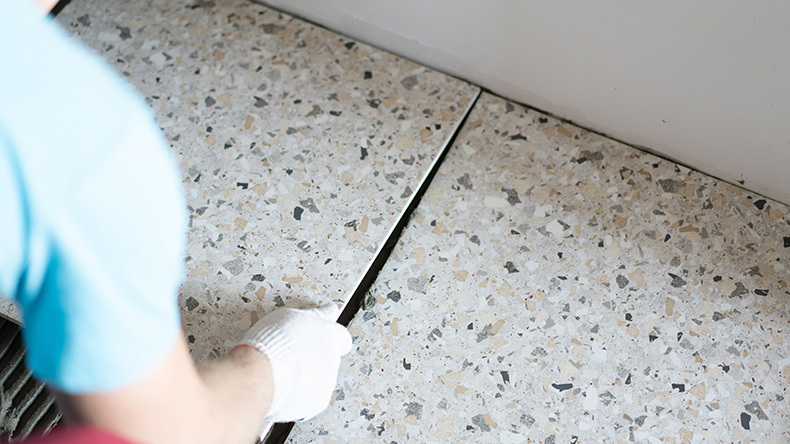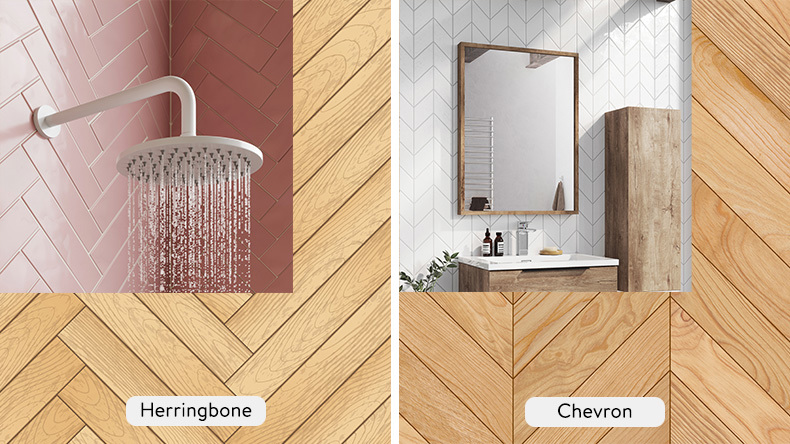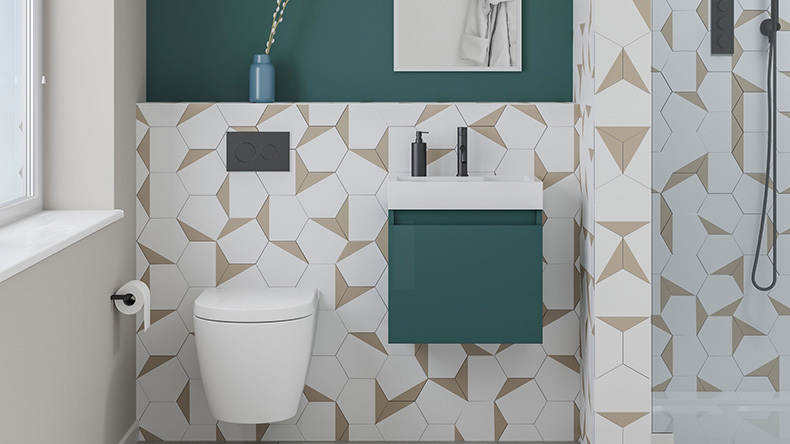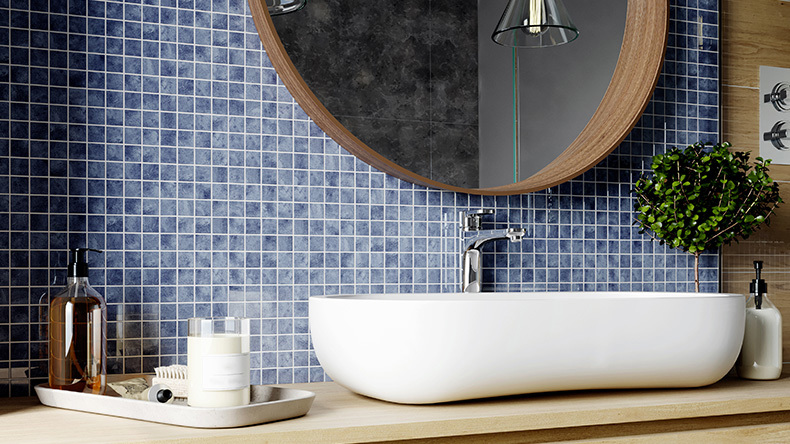Contents:
Ceramic vs Porcelain Bathroom Tiles
Porcelain and ceramic tiles are the most popular options for bathroom flooring as they are resistant to water, chemical cleaners and are available in an array of designs.
Ceramic tiles are made from brown or red clay and tend to be more lightweight than porcelain. Ceramic is also a porous material so is treated with a glaze to ensure it remains resistant to water, making it ideal for bathrooms. These tiles tend to be cheaper than porcelain and are available in a vast array of colours and patterns.
Porcelain is made from white clay and is slightly more premium and durable, making it a great anti-slip option for wet room flooring as the material repels water more effectively. Body porcelain tiles are hard wearing and the colour and pattern runs through the body of the tile, unlike traditional ceramic tiles where the glaze only holds the pattern and can be prone to chipping on the surface. Similarly, glazed porcelain tiles are generally printed and can have a colour body close in shade to the printed surface. They do come at a higher cost compared to ceramic tiles.

Stone Bathroom Tiles
Natural stone tiles are extremely durable and are a great way to invest in your home and add a spot of textured luxury into your bathroom. Granite tiling has become popular in bathrooms, however although it looks great it does have slight disadvantages in that it is more expensive and is susceptible to cracking easily, not only this granite and marble tiling can be easily scratched and are not always resistant to high temperatures. However, the varying colouring and texture of natural stone cannot be replicated by ceramic tile, as it provides unique design accents. Stone tiles give bathrooms a warm, classic look, while basic white ceramic tiles give a more modern contemporary feel.

Different Tile Designs
Now we've discussed the different types of materials used for tiles, let's get into the most popular designs.
Metro Tiles
Taking inspiration from the London Underground, metro tiles are popular in many modern and traditional bathrooms alike. They're usually characterised by a glossy white tile contrasted to a darker coloured grout, which gives a timeless appeal to any space and a great blank canvas to build upon. You can also by metro tiles in a range of different colours and sizes.

Herringbone vs Chevron Tiles
These tiles are similar, but not the same. Here are the key differences between them:
Herringbone tiles are cut at a 90 degree angle, creating a broken zigzag design where the tiles don't slot together as neatly as chevron tiles do. Herringbone tiles tend to be the more popular option and offer a more rustic design, rather than the straight line that chevron tiles create.
Chevron tiles are more V-shaped in design and are cut at a 45 degree angle to create a zigzag style pattern, coming to a point at the top. These tiles can be more expensive and you'll get more tile wastage cutting the tiles to size. Both patterns out of the two can be rotated to any angle you like!

Scallop/Fish Tail Tiles
For a more modern option, scallop or fish tail tiles can add a touch of elegance to your bathroom. Coming in at a higher cost, these tiles are slightly more premium than alternatives we've mentioned but have a gorgeous finish. They be a great design feature, equally looking stylish as a shower backdrop, basin splashback or even as floor tiles.

Hexagonal Tiles
If you're looking for something a little different, hexagonal tiles give a chic, timeless aesthetic. Play around with different colours and shapes and hexagonal tiles can offer an abstract geometric design to your bathroom, adding a statement in any area they're placed in. You can also opt for plain hexagonal tiles with muted colours if you're looking for a minimalist look.

Mosaic Bathroom Tiles
Mosaic tiling offers limitless possibilities to fulfil your own unique design concept. Many people also choose mosaic tiles to highlight fixtures and fittings in their bathroom, such as above wash basins, on shower walls or around vanity units to create a stunning feature. Some mosaic tiles are suitable for use on both walls and flooring offering more flexibility.

Bring More Brightness into Your Bathroom
Light coloured bathroom tiles give an illusion of bigger space, as they reflect light better than darker colours, giving an airy and spacious feel. Using large bathroom tiles in a smaller bathroom i.e. 600mm x 300mm can make the room look significantly smaller, although even smaller tiles i.e. 100mm x 100mm can look good in smaller bathrooms, yet the need for more surrounding grout can often give an unappealing effect. Tile covered walls create a greater style statement than than paint can on its own, providing a more visually exciting effect.
Half Wall Tiles
To give the illusion of more space in your bathroom, we recommend tiling halfway up the wall. This is also a great idea if you're working to a tight budget, as tiles can be expensive!
Cost of Tiling a Bathroom
Depending on the size of your bathroom and the types of tile you choose for your bathroom, the cost can vary dramatically. For more detail, take a look at our insightful blog exploring all the things you need to think about from a costing perspective when tiling a bathroom and how to cut costs.
Tiling the Bathroom Floor
Using the same colour wall tiles as bathroom flooring tiles can create an illusion of a greater space; a great idea for smaller bathrooms. Many people opt for medium sized tiles for bathroom flooring ideal for both small and larger bathrooms. It is important to take note of the spacing between your bathroom furniture and windows, if the spacing is tight, small tiles may be the better option, as they will flow better than larger tiles and require less cuts.
Will Floor Tiles Make my Bathroom Feel Cold?
There is a bit of a misconception when it comes to tiling a bathroom floor. In general, tiles actually retain heat so they should not feel cold on your feet, however this can depend on the surface underneath the tile for example tiling onto wood will create a warmer feel than tiles that are placed on top of concrete. Underfloor heating is a modern solution to warming floors and entire rooms. There are many benefits to under tile heating such as giving you more wall space, the elimination of radiators and low running costs.
For more tiling inspiration, take a look at our blog exploring the best small bathroom tile ideas to discover how to maximise space through tiling.







